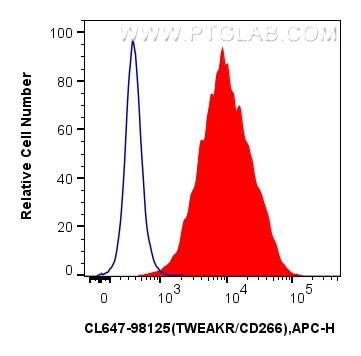Tested Applications
| Positive FC detected in | HT-1080 cells |
Recommended dilution
| Application | Dilution |
|---|---|
| Flow Cytometry (FC) | FC : 5 ul per 10^6 cells in a 100 µl suspension |
| This reagent has been pre-titrated and tested for flow cytometric analysis. The suggested use of this reagent is 5 ul per 10^6 cells in a 100 µl suspension or 5 ul per 100 µl of whole blood. | |
| Sample-dependent, Check data in validation data gallery. | |
Product Information
CL647-98125 targets TWEAKR/CD266 in FC applications and shows reactivity with human samples.
| Tested Reactivity | human |
| Host / Isotype | Rabbit / IgG |
| Class | Recombinant |
| Type | Antibody |
| Immunogen | TWEAKR/CD266 fusion protein Ag13823 Predict reactive species |
| Full Name | tumor necrosis factor receptor superfamily, member 12A |
| Calculated Molecular Weight | 129 aa, 14 kDa |
| GenBank Accession Number | BC002718 |
| Gene Symbol | TWEAKR |
| Gene ID (NCBI) | 51330 |
| Conjugate | CoraLite® Plus 647 Fluorescent Dye |
| Excitation/Emission Maxima Wavelengths | 654 nm / 674 nm |
| Form | Liquid |
| Purification Method | Protein A purification |
| UNIPROT ID | Q9NP84 |
| Storage Buffer | PBS with 0.09% sodium azide and 0.5% BSA, pH 7.3. |
| Storage Conditions | Store at 2-8°C. Avoid exposure to light. Stable for one year after shipment. |
Background Information
TWEAKR (also known as CD266, FN14, TNFRSF12A) is a member of the TNF receptor superfamily which is activated by its ligand, the cytokine TWEAK (TNFSF12). TWEAKR is the smallest member of the TNFR superfamily. TweakR was first described as an FGF-inducible gene that played a role in fibroblast adhesion and migration. Subsequently, the induction of TweakR expression by other growth factors and/or upon tissue injury was observed in multiple cell types, including hepatocytes, endothelial cells, adipocytes, and cardiomyocytes. (PMID: 23073510, PMID: 24409185)
Protocols
| Product Specific Protocols | |
|---|---|
| FC protocol for CL Plus 647 TWEAKR/CD266 antibody CL647-98125 | Download protocol |
| Standard Protocols | |
|---|---|
| Click here to view our Standard Protocols |



